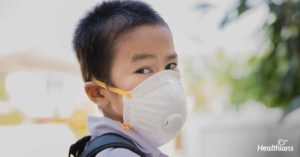Contributed by- Dr. Deepak Parashar
Swine Flu is also known as Swine Influenza or H1N1 (H1 – Hemagglutininand and N1 – Neuraminidases). Influenza viruses are split into three broad groups, namely, Influenza A, Influenza B and Influenza C. Influenza A is the most commonly found virus and H1N1 is a type of it.
Sources of Contamination
- Like seasonal influenza, H1N1 is thought to be transmitted by three routes: Contact Exposure (when contaminated hands is exposed to facial membrane), Droplet Exposure (when infectious droplets are projected onto mucous membrane) and Airborne Exposure(when infectious airborne particles are inhaled).
- Unlike other A influenza viruses that are transmitted by small droplets nuclei, H1N1 Virus is usually transmitted by large particle respiratory droplets and hence requires a less than 6 feet distance between the source and susceptible individual to be present for the effective spread.
- The virus can be spread when a person touches something like, various daily objects that are contaminated with the virus and then touches his or her eyes, nose or mouth without washing the hands.
- Droplets from a cough or sneeze of an infected person move through the air. The virus can then be spread when a person touches respiratory droplets from another person on a surface like a desk, doorknob, child’s toy or phone handset and then touches their own eye, mouth or nose before washing their hands.

High-risk Group
- Infant and young children particularly < 5 years, Adults> 65 years
- Pregnant women and women up to 2 weeks pregnant and postpartum, if exposed
- Patients with low immunity level or certain chronic medical conditions
- Patients on long term cortisone therapy
Signs and Symptoms of Swine Flu
- Fever
- Cough
- Sore throat
- Runny or stuffy nose
- Body ache
- Headache
- Chills
- Fatigue
- Weakness
- Chest discomfort
In addition, vomiting (25%) and diarrhea(25%) has been reported (higher rate than for seasonal flu).
Diagnosis
- Nasal swab
- Nasopharyngeal swab
- Throator Bronchail Alveolar Aspirate
- Endotracheal Aspirate
- Reverse Transcrption Polymerase Chain Reaction (RT-PCR)
- Rapid Influenza Diagnostic Test (RIDTS)
- Direct Immunofluorescence Assay (DFAS)

Swine Flu Prevention
- While coughing and sneezing always cover your mouth and nose with a disposable tissue or your hands in case you do not have a tissue. This way you will not spread the virus and keep the other people safe from the infection.
- Infection control practices should be followed. Properly wash your hands after you sneeze or cough. Alcohol-based hand washes are effective. Maintaining good personal hygiene can be helpful in controlling infection. Never touch your eyes, nose or mouth with unwashed hands.
- Used tissues or masks should be disposed of properly in the dustbins. It is important to keep the surfaces like bedside tables, bathroom shelves, kitchen counters and kids toy clean by wiping them with a household disinfectant according to the directions prescribed on its label. Wiping contact surfaces with hypochlorite solution or household bleach solution is also helpful. Utensils should not be used by others without washing.
- If you have flu-like symptoms like fever, cough, fatigue, sore throat – maintain a distance of at least 1 meter from other people. Avoid going to school, work or any public places. Do not kiss, hug or shake hands while greeting. Do not spit in public places as this can easily spread the virus. Staying at home with limited contact with other people is advised.
- Seek medical advice before your symptoms get worse. Never take medicines without the doctor’s consultation. Have plenty of rest and eat nutritious food and fluids. exercise as much as you can. Also, keep a regular check on body temperature.
- Farmers should wear face masks and gloves when dealing with infected animals to prevent the transfer of the Swine Flu virus.

Hygiene Etiquette To Stay Safe Against Swine Flu
Respiratory etiquette – Cover nose and mouth when coughing and sneezing
Hand washing etiquette – There are three Cs:
- Clean – Wash your hands often. Scrub your hands for at least 20 seconds with soap and water or use an alcohol-based hand cleaner.
- Cover – Use a tissue to cover your mouth and nose when you cough or sneeze and keep the tissue wrapped.
- Contain – Stay home if you are sick or have limited contact with those who are infected. Do not go out in public places as it will put other people at the risk of getting infected.
Triple layer surgical masks – Masks will prevent the contact with the germs up to a certain level by covering the mouth and nose.
- Place over nose, mouth and chin.
- Fit flexible nose piece over nose bridge.
- Ensure there are no gaps on either side of the mask, adjust to fit.
- Do not let the mask hanging from the neck.
- Change the mask after 6 hours or as soon as they become wet.
- Disposable masks are never to be reused and should be disposed of properly.
- While removing the mask great care must be taken to not to touch the potentially infected outer surface of the mask.
- N-95 and N-99 Filtering masks are the most recommended.
- Personal protective equipment like gloves and scarfs can also be helpful.
(Learn about Swine Flu Causes and Treatment in Hindi here.)




